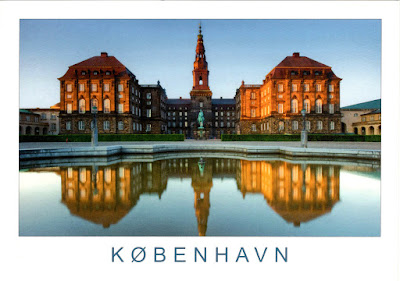June 12, 2016
2608 DENMARK (Hovedstaden) - Christiansborg Palace
Located on the islet of Slotsholmen in central Copenhagen, Christiansborg Palace is the seat of the Danish Parliament, the Danish Prime Minister's Office and the Supreme Court of Denmark. Also, several parts of the palace are used by the Danish monarch, including the Royal Reception Rooms, the Palace Chapel and the Royal Stables. Thus it is the only building in the world that houses all three of a country's branches of government.
The present building, the third with this name, is the last in a series of castles and palaces constructed on the same site. The first was Absalon's Castle, built in 1167 by Bishop Absalon of Roskilde. It was frequently under attack, and in 1369, following a conflict with king Valdemar IV of Denmark, the Hanseatic League sent 40 stonemasons to demolish the castle stone by stone. During the years after that, the ruins were covered with earthworks, on which a new stronghold, Copenhagen Castle, was built.
In 1417 the castle was occupied by the king, and in the middle of the 15th century it became the principal residence of the Danish kings and the centre of government. In the 18th century King Christian VI commissioned architect Elias David Häusser to build the first Christiansborg Palace, which was erected between 1733 and 1745, being the largest palace in Europe at the time. The palace and church were ruined by a fire in 1794, but the showgrounds were saved.
The architect Christian Frederik Hansen started building the second Christiansborg in 1803 in a French Empire style. The palace was finished in 1828, but King Frederick VI had decided he didn't want to live there. Frederick VII was the only monarch to live in the palace, between 1852-1863. The second Christiansborg burned down in 1884. Saved were the showgrounds and Hansen's chapel. The third (and current) Christiansborg was built between 1907 and 1928 after the plans of Thorvald Jørgensen.
The palace was to contain premises for the royal family, the legislature and the judiciary, and was built in Neo-baroque style in reinforced concrete with granite-covered facades. Fragments from C.F. Hansen's palace were preserved in the north facade. The original roof was tiled, but after a national collection, the tiles were replaced with copper in 1937-1938. A weather vane with two crowns was later added to the tower, and at 106 meters became the tallest tower in the city.
About the stamp
The stamp is part of a set of four definitive postage stamps, depicting Queen Margrethe II, about which I wrote here.
References
Christiansborg Palace - Wikipedia
Sender: Krystyna Betiuk (direct swap)
Sent from Copenhagen (Capital Region / Denmark), on 05.06.2016
Photo: Yen Beat
Etichete:
DENMARK,
Palaces / Castles / Fortress
Locaţia:
Copenhaga, Danemarca
Subscribe to:
Post Comments (Atom)


No comments:
Post a Comment